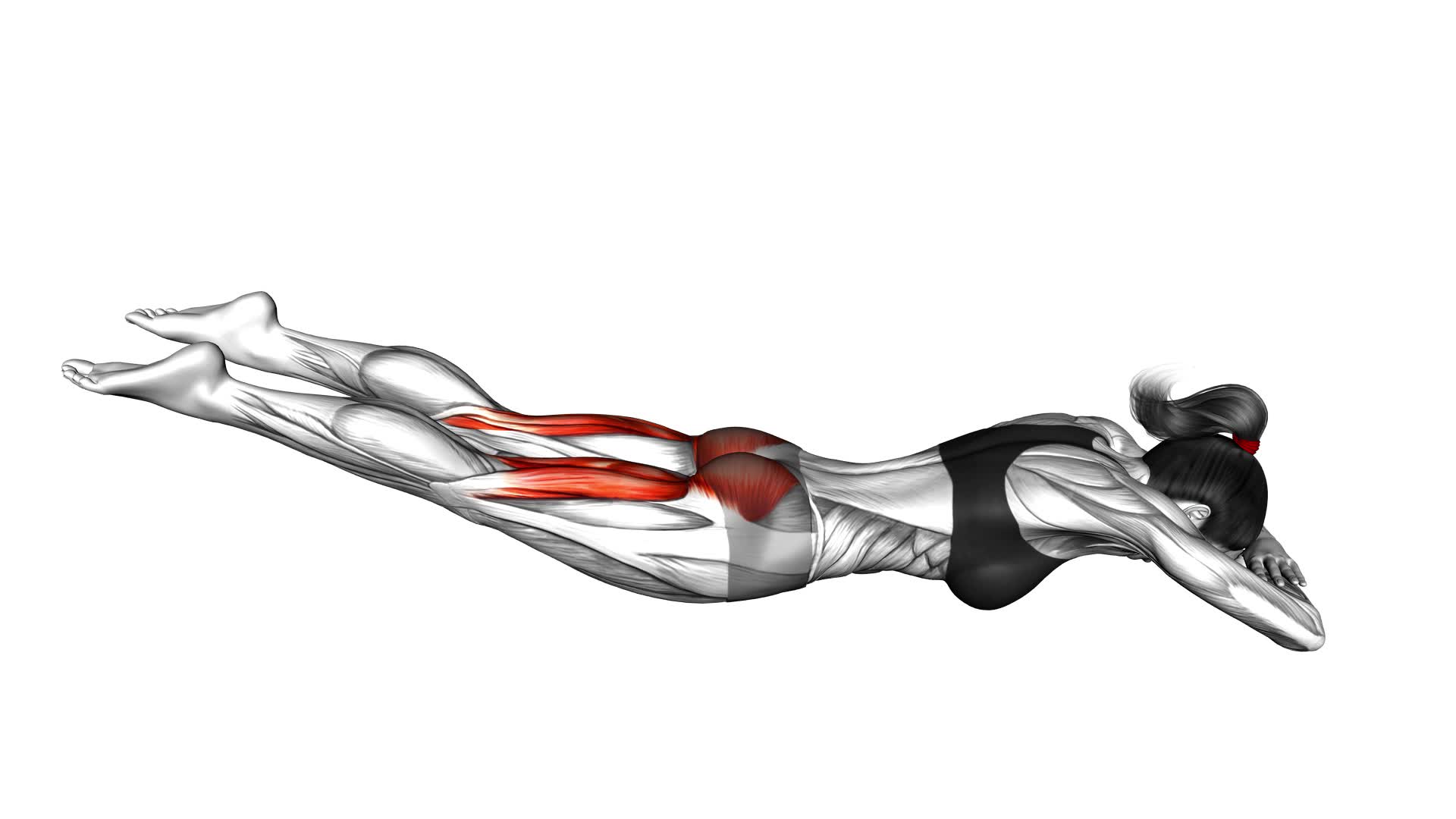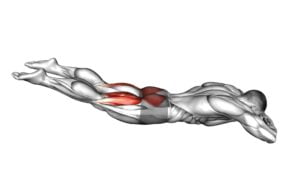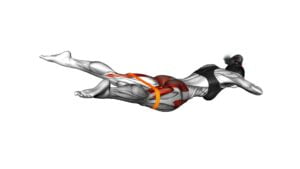Lying Hyperextension Hold (female) – Video Exercise Guide & Tips

Are you looking to strengthen your core and improve your lower back stability? Look no further than the Lying Hyperextension Hold! This exercise is perfect for females who want to target those key areas.
Watch This Exercise Video
In this quick video guide, we'll show you the proper technique and form to maximize your results. Say goodbye to common mistakes and hello to a more challenging workout.
Get ready to take your fitness to the next level with our helpful tips and variations. Let's get started!
Key Takeaways
- The lying hyperextension hold targets the lower back, glutes, and hamstrings, leading to significant strength gains in these areas.
- Regularly performing the exercise can improve posture and reduce the risk of lower back pain.
- Engaging the core muscles is essential during the exercise, leading to overall core strength improvement.
- To increase the difficulty of the exercise, various modifications can be made, such as incorporating resistance bands or using ankle weights.
Benefits of the Lying Hyperextension Hold
You can experience significant strength gains in your lower back and glutes by incorporating the lying hyperextension hold into your workout routine. This exercise primarily targets the muscles in your lower back, glutes, and hamstrings. By regularly performing the lying hyperextension hold, you can strengthen these muscles, improve your posture, and reduce the risk of lower back pain.
To incorporate the lying hyperextension hold into your workout routine, start by lying face down on an exercise mat. Place your hands by your sides or behind your head, whichever is more comfortable for you. Engage your core and squeeze your glutes as you lift your upper body and legs off the ground. Hold this position for a few seconds, making sure to keep your neck neutral and your spine aligned. Slowly lower your body back to the starting position and repeat for the desired number of repetitions.
To maximize the benefits of the lying hyperextension hold, it's important to maintain proper form throughout the exercise. Focus on engaging your glutes and lower back muscles to lift your body, rather than relying on momentum. Start with a lower number of repetitions and gradually increase as you get stronger. Remember to listen to your body and stop if you experience any pain or discomfort.
Proper Technique and Form
To ensure proper technique and form for the lying hyperextension hold, focus on engaging your glutes and lower back muscles throughout the exercise. This will help you maintain stability and prevent any unnecessary strain on your body.
When performing the exercise, lie face down on a hyperextension bench with your feet securely anchored. Place your hands behind your head or across your chest. From here, exhale and lift your upper body off the bench, extending your back as far as comfortable. Hold this position for a few seconds before slowly lowering your body back down to the starting position.
One common error to avoid is using momentum to lift your upper body instead of relying on your muscles. This can lead to an ineffective workout and potentially cause injury. Remember to control the movement and focus on engaging your glutes and lower back muscles.
Some key points to keep in mind during the lying hyperextension hold are to maintain a neutral spine position, avoid arching your back excessively, and keep your neck aligned with your spine. It's also important to breathe throughout the exercise, inhaling as you lower your body and exhaling as you lift it.
Common Mistakes to Avoid
One common mistake to avoid when performing the lying hyperextension hold is relying on momentum to lift your upper body instead of engaging your muscles consistently throughout the exercise. This can happen when you use a swinging motion or jerk your body upwards, rather than using controlled movements. By relying on momentum, you aren't effectively targeting the muscles you're trying to work, and you also increase your risk of injury.
Another common error isn't maintaining proper form throughout the exercise. It's important to keep your body in a straight line from your head to your toes, and avoid arching or rounding your back. This ensures that you're engaging the correct muscles and minimizing the strain on your back.
To avoid these common mistakes and ensure your safety, it's important to practice proper technique and form. Start by engaging your core muscles and squeezing your glutes as you lift your upper body. Focus on using a slow and controlled motion, rather than relying on momentum.
Additionally, pay attention to your body alignment and maintain a neutral spine throughout the exercise. Remember, it's better to perform the exercise correctly with lower intensity than to risk injury by using improper form.
Tips for Increasing Difficulty
To increase the difficulty of the lying hyperextension hold, incorporate resistance bands or ankle weights. These additional tools can provide the extra challenge needed to take your workout to the next level.
Here are some progression tips and advanced modifications to help you increase the difficulty of this exercise:
- Resistance Bands: Attach a resistance band around your ankles or knees to add resistance to the movement. This will require your muscles to work harder and increase the intensity of the exercise.
- Ankle Weights: Strap on ankle weights to add extra weight and resistance to your legs. This will make the exercise more challenging and help to strengthen your muscles even further.
- Elevate Your Feet: Place your feet on an elevated surface, such as an exercise bench or step, to increase the range of motion and engage your muscles in a different way. This will provide a more advanced variation of the lying hyperextension hold.
By incorporating these progression tips and advanced modifications into your lying hyperextension hold, you can continue to challenge yourself and make progress in your fitness journey.
Remember to listen to your body and gradually increase the difficulty level to avoid any injuries.
Variations and Modifications
Try incorporating variations and modifications to challenge yourself even further during the lying hyperextension hold. By adding progressions and utilizing different equipment options, you can intensify the exercise and target specific muscles more effectively.
One variation you can try is the weighted hyperextension hold. Instead of performing the exercise solely with your body weight, hold a dumbbell or a weighted plate against your chest. This added resistance will engage your muscles even more, making the exercise more challenging.
Another progression is the single-leg hyperextension hold. Lift one leg off the ground while performing the exercise, focusing the work on the opposite glute and hamstring. This variation not only increases the difficulty but also improves balance and stability.
If you have access to equipment such as a hyperextension bench or a Roman chair, you can perform the exercise using these tools. These equipment options provide additional support and allow for a greater range of motion, enabling you to target your glutes and hamstrings more effectively.
Remember to always maintain proper form and listen to your body. As you incorporate these variations and modifications, gradually increase the intensity to avoid overexertion or injury.
Stay consistent and challenge yourself to see continuous progress in your lying hyperextension hold.
Frequently Asked Questions
How Many Times a Week Should I Incorporate the Lying Hyperextension Hold Into My Workout Routine?
You should incorporate the lying hyperextension hold into your workout routine a few times a week. This exercise is great for building core strength and stability.
By regularly including it in your workouts, you can see improvements in your overall core strength and posture. Make sure to listen to your body and start with a frequency that feels comfortable for you.
As you get stronger, you can gradually increase the number of times you do this exercise each week.
Can the Lying Hyperextension Hold Help Improve Posture and Alleviate Lower Back Pain?
The lying hyperextension hold is a great exercise to improve posture and alleviate lower back pain. By engaging your core and back muscles, this exercise helps strengthen the muscles that support your spine, leading to better posture and reduced pain.
Incorporating this exercise into your routine a few times a week can make a noticeable difference. Remember to start with proper form and gradually increase the duration for maximum benefits.
Is It Safe for Beginners to Attempt the Lying Hyperextension Hold Exercise?
Yes, the lying hyperextension hold exercise is safe for beginners to attempt. It's important for beginners to start with modifications that suit their fitness level.
This exercise can help strengthen your lower back muscles, improve posture, and alleviate lower back pain. By gradually increasing the intensity and duration of the hold, you can gradually progress and build strength.
Remember to listen to your body and stop if you experience any pain or discomfort.
Are There Any Alternative Exercises That Target Similar Muscle Groups as the Lying Hyperextension Hold?
Looking for alternative exercises that target similar muscle groups as the lying hyperextension hold?
There are a few options you can try. These exercises can help strengthen your lower back, glutes, and hamstrings just like the lying hyperextension hold.
Some alternatives include the superman exercise, the bird dog exercise, and the bridge exercise.
Each of these exercises has its own benefits, so give them a try and see which one works best for you!
Should I Be Using Any Equipment or Props While Performing the Lying Hyperextension Hold?
When performing the lying hyperextension hold, you may wonder whether you should be using any equipment or props. Using proper form is essential for this exercise to target the desired muscle groups effectively.
As for equipment, you can perform the lying hyperextension hold without any additional props. However, some people prefer to use a stability ball or a bench for added support and stability.
It's important to find what works best for you.
Conclusion
In conclusion, the lying hyperextension hold is a beneficial exercise for strengthening the lower back and core muscles.
By maintaining proper technique and form, you can prevent common mistakes and maximize the effectiveness of this exercise.
To increase difficulty, you can try variations and modifications.
Remember to listen to your body and start with a level that's suitable for your fitness level.
Incorporating this exercise into your routine can lead to improved posture and overall strength.

Author
Years ago, the spark of my life’s passion ignited in my mind the moment I stepped into the local gym for the first time. The inaugural bead of perspiration, the initial endeavor, the very first surge of endorphins, and a sense of pride that washed over me post-workout marked the beginning of my deep-seated interest in strength sports, fitness, and sports nutrition. This very curiosity blossomed rapidly into a profound fascination, propelling me to earn a Master’s degree in Physical Education from the Academy of Physical Education in Krakow, followed by a Sports Manager diploma from the Jagiellonian University. My journey of growth led me to gain more specialized qualifications, such as being a certified personal trainer with a focus on sports dietetics, a lifeguard, and an instructor for wellness and corrective gymnastics. Theoretical knowledge paired seamlessly with practical experience, reinforcing my belief that the transformation of individuals under my guidance was also a reflection of my personal growth. This belief holds true even today. Each day, I strive to push the boundaries and explore new realms. These realms gently elevate me to greater heights. The unique combination of passion for my field and the continuous quest for growth fuels my drive to break new ground.







